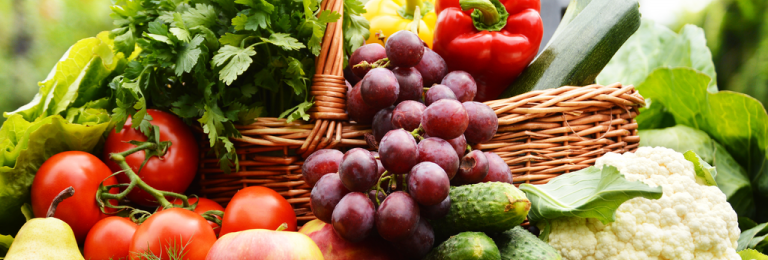Vegetable & Fruit Storage
Why think about it?
We can do our part at home to save food from ending up in the compost pile or landfill by following a few basic principles on food storage:
• Take stock of what’s on hand and plan meals to prevent waste
• Use up produce that goes bad quickly first
• Store less perishable vegetables and fruit properly
• Frozen vegetables and fruits are great to have on hand. Be sure to keep them well-sealed and use within 6 months to maintain their quality.
How to store and use produce:
• Bananas, berries and melon tend to ripen quickly. Use them within 3 days of getting them home or freeze berries in a single layer on a baking sheet then bag once frozen. Peel cut-up, over- ripe bananas and freeze to use in smoothies and baking.
• Apples, pears, oranges and grapefruit tend to last longer so they can be saved in the fridge for later in the week. Be sure to store apples and pears separately from other produce as they let off a gas called ethylene which causes other produce to ripen faster.
• Lettuce goes bad quickly so use it up first and save spinach for later in the week. If spinach is starting to wilt, steam it all and squeeze out the liquid then use it in pasta, soup or eggs. Spinach can also be frozen and added to smoothies. Another good tip for reviving any wilted vegetables is to soak it in water until it perks up.
• Herbs are the best way to add flavour to your food but they can become slimy quickly. Store them in a jar of water with a plastic bag overtop with a few holes cut out. They should be kept in the fridge except for basil which will turn black, so keep it on the windowsill.
• Cucumber should get used up in 3-5 days. Cut it up for an easy and hydrating snack in the afternoon.
• Broccoli should get used up before it begins to yellow. If you’ve bought too much, blanch it in boiling water for 1 minute then dry well and freeze in an airtight bag or container.
• Dark Leafy Greens. Chard will be the first green to spoil so use it up in 3 or 4 days. Collard greens last the longest so save them in a bag in the fridge. Kale is somewhere in the middle, but if you’ve bought too much, pack it well-dried into a freezer bag then pull out to crumble into smoothies, soups, pasta, etc.
• Avocados should be purchased green and then allowed to ripen on the counter next to the bananas. They are ready when you can gently push in at the neck. Once soft, keep them in the fridge for a week or 10 days and if you only eat half, save the other half with the pit inside, covered and refrigerated for a day.
• Root veggies include carrots, turnips, potatoes, onions, garlic and squash. These have longevity! Keep them in a cool, dark cupboard or cellar and they’ll keep for two weeks or longer. If they grow sprouts or eyes, that doesn’t mean they’ve gone bad. Just cut them out when you are preparing to cook them.
• Cabbage is so affordable and underappreciated for its longevity and versatility. Once lettuce has been used up, cabbage makes a great salad base. But it’s not just for coleslaw! Cabbage is delicious braised with apples or added to soups.
For more information
• Check out Health Canada for everything related to food safety and remember, when in doubt, throw it out!
• Half Your Plate.ca
• Residential Food Waste Prevention
• Love Food Hate Waste Canada
